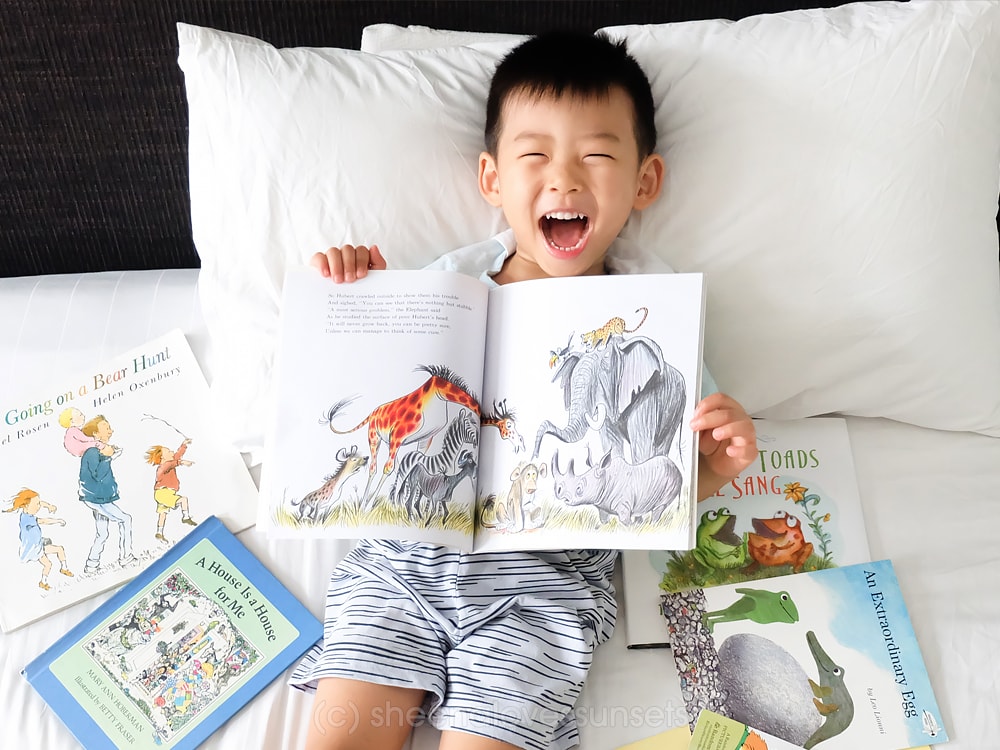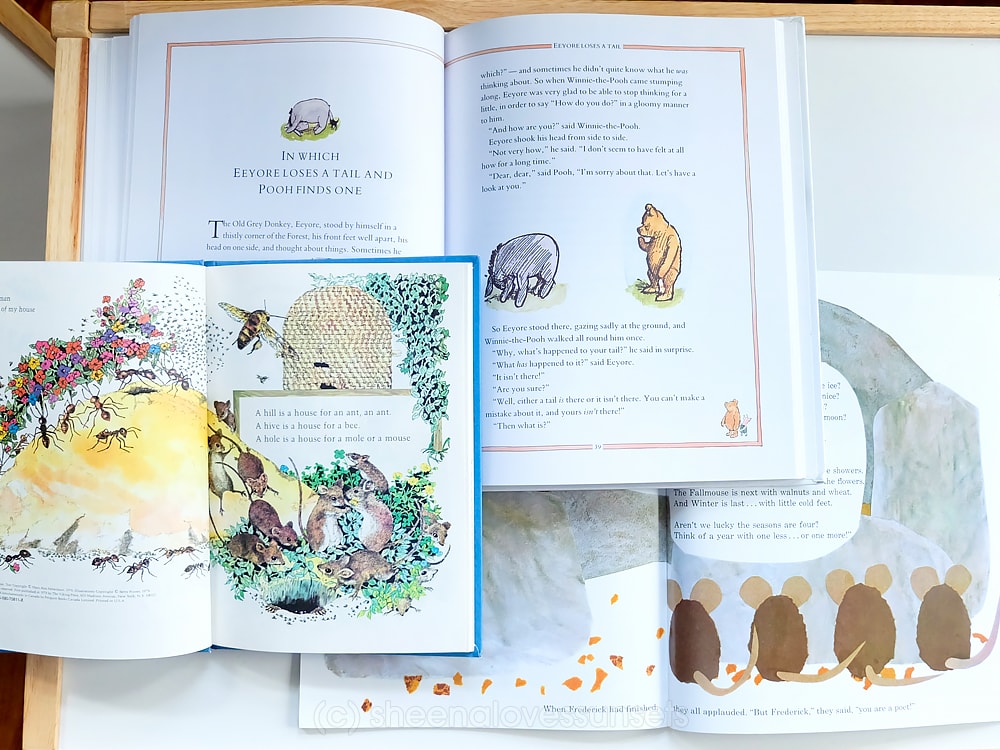
I didn’t think I could do it, but I finally did: I’ve gotten rid of a TON of kids’ books on our shelf!
As a book lover, I always had the idea that the more books, the better. But I recently realized that this isn’t always the case. I’d like to share with you my journey and the many reasons I decided to curate our children’s books.
More Is Not Always Better
It’s unbelievable how much books we’ve accumulated in just the past 3.5 years. And to think, all these books are for ages 4 and below. Imagine all the books we’d be accumulating as the kids grow older!
As I slowly move towards a more minimalist lifestyle, I’ve learned to be more discerning about the books I buy and keep and that includes the ones I buy for my kids. First of all, when the shelves are full with a mix of good and bad books, it’s so easy to miss the treasures. When I was purging books, I noticed a handful of really good ones that we’ve totally forgotten!
Second, kids take in whatever we give them. It’s like food. When we feed them with junk, that’s all they ask for. When our shelves contain not-so-good books, kids take these in. Either they learn to enjoy poorly written books or they end up thinking that these are what books are; simple, dry, uninteresting. To me, both are undesirable outcomes.
From my experience, having one really good story book is better than having 3 that are poorly written and presented. A good story has the ability to take you places, make you think and to know beyond what you know.
Good books are memorable, bad books are forgettable at best.
Fill the Mind With Beauty

I was recently introduced to Charlotte Mason’s concept of “Living Books,” which basically refers to well-written books that “pull you into the subject and involve your emotions, so it’s easy to remember the events and facts” (unlike those dry textbooks we were used to in school.) At the same time, she also warns against books that she refers to as “twaddle,” which are books that talk down to the child, are predictable and lazy.
Now, I’m not a “purist” about living books and we definitely have some twaddle on our shelves (some, I don’t plan on removing at all!) But I can definitely see the difference in my son’s reactions whenever we read books that are well-written and beautifully told.
“Whatever is true, whatever is noble, whatever is right, whatever is pure, whatever is lovely, whatever is admirable–if anything is excellent or praiseworthy–think about such things.” Philippians 4:8
The truth is, beauty sticks.
Beautiful stories coupled with beautiful pictures take us to beautiful places. Intricate stories make us think. Well-drawn artworks inspire. When we expose our kids to beauty, they learn to appreciate and long for it. So we should do that more often; whether it’s through the books they read, the music they listen to, the toys they play with or even the places they visit (I’m cheering for more museum visits!)
Let’s fill their lives with whatever is pure, beautiful and admirable.
What Makes a Book “Good?”
I’m sure a lot of people have a lot of different answers to this. My definition of what a good book is might be different from yours. Something I think will be great for my child may not be the same as what you think will work for yours. And that’s okay!
The whole point of why I wanted to share what we are doing right now isn’t to “teach” about what makes good books great. Instead, my goal is to encourage parents to be more discerning about what they get for their kids.
Here’s my personal criteria though for choosing the books I buy and in deciding which books stay in our shelves.
- The book is well-written, especially if it’s a story book: No dumbed down words. The story makes the child think, laugh or feel different emotions. The story is unique or not predictable (especially as the kid gets older)
- The book is well-presented: Layout is nicely done. Artworks and words are appropriately displayed and not distracting. Font is not too hard to read or messy.
- The book is nicely illustrated, if it’s a picture book: I know “nice artworks” sounds very subjective. But my general rule now is to avoid books that look like they took cliparts or generic stock photos online. Hehe. (I guess I’m also a little more particular about pictures since I work as an illustrator and designer.)
Consider Quality Books as Investments
If I could tell people to gift my kids books instead of toys, I really would. Actually, if I could tell people to give them experiences (museum visits, ice cream dates, picnic lunches) instead of things, that would be even better! Because oh, the places you’ll go with books and experiences! In my own opinion, toys just don’t compare, no matter how expensive or hi-tech those toys may be.
I used to scrimp on books. It used to be that if there were cheaper alternatives to the same topic, I would definitely buy the cheaper one. Books can get really expensive for sure. But I’ve now come to realize that just because two books cover the same topic, doesn’t mean they’re both going to be effective in teaching your kids.
When I was starting to homeschooling Luke, I got him a devotional. I figured, a devotional book is a devotional and they were all the same. How wrong I was! It was hard to read the book aloud to Luke because of the way the sentences were phrased. It wasn’t conversational at all and I had to do a lot of explaining outside of the text.
I noticed the difference when I finally got him a better devotional. And what a world of difference it was. (Related post: Teaching Kids to Begin the Day with God, where I share my recommended materials and devotionals!)
Note: I’m NOT saying that all expensive books are quality books. Trust me, I’ve seen my fair share of bad but expensive ones. Instead, I want to encourage you to consider how great books can be investments in case you encounter one that takes you aback because of its price. (And hopefully, dissuade you from getting cheaper, badly written alternatives!)
Final Tips:
- Don’t be fooled by bestseller lists: As a new mom, I had absolutely no idea what “good” children’s books were so I relied on booklists I found on pinterest and Amazon’s list of bestsellers. Turns out, just because a book is popular, doesn’t mean it’s good. Who knew? Haha.
- Consider getting secondhand books: If budget’s an issue, go for this! Personally, I buy secondhand books from local online sellers as long as the conditions of the books are still good. In fact, there are so many amazing deals you can get especially if you’re looking for classics and more popular, timeless books. (Note: NOT recommending this for baby books because babies chew on books when left unattended and I don’t feel comfortable letting my baby gnaw on an old book. Plus, I can only imagine the number of bites it already got from its previous baby owner. Eep!)
- Not all books have to be “educational”: Make reading fun by letting your kids explore worlds through the characters and stories they meet in the books. Some books are silly and written for pure entertainment. Sometimes they have no “moral” in the end (gasp!) But if you ask me, I don’t see anything wrong with that at all!
—
And because a lot of you guys have been asking me on Instagram, I’ll be sharing some booklists soon! I am no expert in beautiful books (I’m still learning too!) but I would love to share with you guys books that we treasure in our family.
I’d also love to hear about books you and your kids love! Share them with me in the comments below!